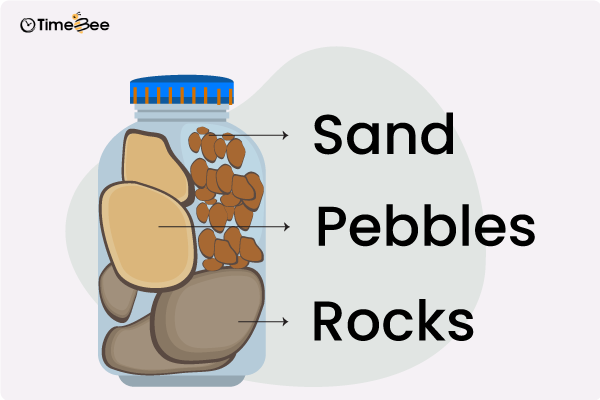Content
Content
The right time management techniques can streamline your business productivity and ensure your workers remain on track during stressful times. Employers prefer workers with an exemplary track record of efficiency and dedication, which makes for a highly sought-after skill.
Employers should also familiarize themselves with these techniques to better implement them while managing teams of all sizes. This also allows them to create more efficient workflows.
Here are 9 time management techniques you can use today to ensure effective time utilization.
What Are Time Management Techniques
Time management techniques help utilize limited resources more efficiently so the most important tasks are taken care of first. They prioritize peak working hours for optimum output and ensure you work at maximum energy levels.
The main objective of implementing a time management strategy is to ensure tasks are completed on schedule without sacrificing quality.
Some of the more popular time management techniques include Pomodoro and Pareto Analysis. Others, like the Eisenhower Matrix and MoSCoW, are less commonly known but equally effective.
Modern techniques, such as time-tracking software, project management, and time-blocking methods, greatly enhance productivity.
Let’s examine why these strategies are needed and how employers and managers benefit from them.
What Is The Need For Time Management Techniques
Time management techniques are essential for several reasons, as they address common challenges people face in today’s fast-paced and demanding world. Here are some key reasons highlighting the need for time management techniques:
- Increased Productivity: Effective time management allows individuals to prioritize tasks and focus on what matters most. People can accomplish more in less time by organizing and planning, leading to increased productivity.
- Reduced Stress: Poor time management often leads to stress and anxiety. Individuals may feel overwhelmed when tasks pile up and deadlines approach without a clear plan. Time management techniques help distribute workload and alleviate stress.
- Improved Decision-Making: By allocating time wisely, individuals can make better decisions. They can evaluate options, consider alternatives, and choose the most effective action.
- Enhanced Goal Achievement: Time management is crucial for setting and achieving goals. By breaking down larger objectives into smaller, manageable tasks, individuals can progress consistently and stay on track toward their long-term goals.
- Better Work-Life Balance: Time management enables individuals to allocate time for work, personal, and leisure activities. Balancing work and personal life contributes to overall well-being and prevents burnout.
- Professional Advancement: Effective time management is often key to career success. Those who can manage their time well are more likely to meet deadlines, complete projects successfully, and demonstrate reliability, which can lead to career advancement.
9 Time Management Techniques
1. Pareto Analysis (a.k.a., the 80/20 rule)

Pareto Analysis, also known as the 80/20 rule, is an effective management strategy for better accountability and easier workflow integration. Essentially, the principle teaches us that 80% of the results come from putting in 20% of the work.
As simple as this technique is, some might believe it might not work. However, this technique works if you know how to strategize it properly. Using Pareto Analysis, you can find out what tasks need the highest priority, so you can do 20% of them to achieve massive results.
Once you have figured out the tasks that need attention, you can amplify them to bring about the most significant change.
2. Pomodoro Technique

The Pomodoro technique requires you to work for a 25-minute burst and take a 5-minute break afterward. After you have finished 4 Pomodoro, after working 2 hours, take a more extended break, around 15 minutes to half an hour.
This technique was created by Italian inventor Francesco Cirillo and popularized in the 1980s. Its popularity and staying power can be attributed to its versatility, efficacy, and simplicity.
Follow these steps to implement Pomodoro for your team:
- Choose a task you want to complete
- Set a 25-minute timer (Pomodoro) and work on the task with concentrated focus and purpose. Measure the time using a time-tracking app like TimeBee.
- Take a 5-minute break.
- Repeat the cycle of 25-minute work and a 5-minute break four times
- After four Pomodoros, reward yourself with a more extended break of 20-30 minutes
It is a highly effective technique, breaking complex projects into smaller, more manageable chunks and improving concentration and focus. Plus, you feel good after completing a task as you can take breaks between tasks to refresh yourself.
Start Tracking Your Time Today
Get TimeBee
3. Eisenhower Matrix

The Eisenhower Matrix was popularized by Steven Covey, author of the international best-seller 7 Habits of Highly Successful People. The technique was created by President Eisenhower but made famous by Covey in his book.
This productivity technique helps prioritize tasks based on their urgency and time significance. It streamlines the decision-making stage, prioritizes urgent tasks, and helps delegate mundane or repetitive tasks.
The matrix consists of four quadrants, each showing a different category of tasks, and is an excellent alternative to the Pomodoro technique and other time management techniques. All your tasks, irrespective of their complexity, will fall into one of the four quadrants:
- Urgent & important tasks: Projects to be completed urgently.
- Not important & urgent tasks: Projects to be scheduled.
- Urgent & Unimportant tasks: Projects to be delegated.
- Not urgent & unimportant tasks: Projects to be deleted.
4. MoSCoW

MoSCoW is a time management strategy that prioritizes tasks and work effectiveness. It helps break down things according to their priority so you can meet deadlines. It’s also a great technique to give all team members a clearer view of the bigger picture, ensuring they are all on the same page.
The MoSCoW time management method divides project requirements and features into four categories:
- Must-have: The project must include the critical components to accomplish its primary objectives and timelines. The inclusion of these could compromise the project’s success.
- Should have: These are important but not vital tasks. They provide value to the project but are optional for its immediate success. If resources and time allow, they may be considered for inclusion.
- Could have: These are desired features or needs that would be wonderful but are not required for the project to succeed. If there is extra time and resources, they can be implemented.
- Will not have: These elements are expressly excluded from the project scope. They are judged excessive and won’t be considered during the project’s development lifecycle.
5. Time Blocking Method

Time Blocking is a very straightforward time management technique. It helps you schedule your tasks into timed segments, allowing you to contribute time resources to tasks you want to finish. You can break down your projects into smaller sub-tasks to prevent adding complexities to your work while maintaining focus. It also ensures you’re one step closer to achieving your overall goal daily.
So, let’s say you know that you must do several difficult chores in the coming week. Plan your week appropriately, scheduling each job in your calendar. For highly demanding projects, divide your work over several days, adding time blocks of three or more hours each day.
Let’s take another scenario. You must manage several smaller tasks. To handle them all, combine them and add one time block (this time management approach is known as task grouping).
Time blocking is one of tech billionaires’ most straightforward and often-used time management techniques.
6. Getting Things Done (GTD) Method

The GTD method involves removing all of your tasks from your mind and breaking them down into smaller, more manageable chunks.
It breaks down your projects into prioritized queues so you can take care of the important things first. Famous productivity consultant David Allen created it and works on a straightforward principle: decluttering your mind.
He observed that the more things bother you in the back of your mind, the more effort and time it takes to complete them all. Consequently, you spend more time thinking about them instead of doing them, leading to stress and anxiety.
Here are the steps you need to follow to implement the GTD time management strategy:
- Capture: Collect what has your attention
- Clarify: Process what it means
- Organize: Put it where it belongs
- Reflect: Review frequently
- Engage: Simply do
7. The 10 Minute Rule

The 10-minute rule is a great way to assess your goals’ progress continuously and helps you remain focused on a single task. This enables you to avoid burnout, eliminate procrastination, and stop you from multitasking.
Basically, you work on a task for 10 minutes and then assess whether you want to work for another 10 minutes. You keep repeating this process until you are 100 percent satisfied with your progress.
Here’s how to implement it:
- Select a task.
- Start working on it immediately.
- After your time tracker has counted ten minutes, take a moment to look at your progress and energy. Do you want to stop working on the task, or do you wish to continue for 10 minutes more?
- Work for 10-minute chunks until you want to stop working on this task for the day.
As you are only required to work on your activity for 10 minutes, breaking it down into smaller time chunks can help you create momentum.
Even with larger chores, working for 10 minutes simultaneously keeps you from feeling overwhelmed. Given that 10 minutes is a short time, odds are you’ll work for further 10-minute sets after the first one.
Starting work quickly after selecting a task ensures you won’t have time for negative thoughts or predictions. There will be less opportunity for procrastinating because you will make it a habit to jump right into work.
Psychologically, tackling a 90-minute assignment in 9×10 minute portions is simpler than facing it head-on.
8. Pickle Jar Theory

The pickle jar theory is a time management technique that helps prioritize tasks and work progress in a specific arrangement. The pickle jar is also known as the bucket of rocks theory or the jar of life theory and was developed by Jeremy Wright in 2002.
Its basic principle is that time is a finite resource, so we must make the most of it, and prioritizing important tasks helps achieve that.
In short, the pickle jar is an analogy in which the jar represents our usual day, and the sand, pebbles, and rocks reflect our daily activities. Furthermore, other authors add another element to the equation— water- representing personal life.
We can stuff the jar with various duties and activities. However, we must adhere to each activity’s precise order and time estimate. As a result, the pickle jar idea assists us in estimating how long it will take to complete a piece of work (rocks, pebbles, or sand).
The technique urges you to examine how you utilize your time daily. You might have done a lot of work that day, but it’s usually completing mundane tasks that are sand. You need to reassess your priorities to focus on finishing the rocks, which equates to the most change.
9. Eat That Frog Technique

Eat that frog is a popular time-managing technique to beat procrastination. We all habitually put off important tasks until the last second. Eat that Frog turns this concept on its head and theorizes that eating a frog is painful, but putting it on the back burner will only increase your suffering.
So, tackle the most important tasks first to get things over with. Hence eating the frog.
Here’s how you can eat the frog:
- Define your goals and write them down.
- Break those goals down into tasks.
- Break those tasks down into the smallest possible subtasks.
- Prioritize your tasks, and delete or delegate tasks you don’t need to do.
- Schedule time on your calendar daily, ideally first thing in the morning, to work on your highest-priority goal task.
- Focus on your goal task (your frog) during your scheduled time, and work on it until it’s complete. (This is the actual eating of the frog.)
Key Takeaways Of Techniques
The goal of all these techniques is to simplify your work time so your productivity remains high even though your energy might not be at its highest. These management techniques help maximize your output by reducing distractions and meaningless tasks.
They help simplify your workflow so you don’t get sidetracked and can work with limited resources. These techniques also encourage you to be accountable to yourself for your productivity goals so you can beat the odds to meet them.
The vast majority of time-tracking techniques encourage you to organize your workflows to save time further and become critically aware of unproductive and time-wasting habits. They also encourage you to use productivity enhancement and time-tracking tools.
These tools help you stay focused, efficient, productive, and on track with your goals. With the right tools at your fingertips, you can boost your output to the next level.
If you need a reliable, accurate, and robust time-tracking tool to streamline your workflows and hold you accountable for your goals and deadlines, TimeBee is the perfect answer.
Similar Reading



